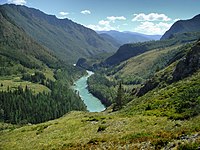Katun (river)
This article needs additional citations for verification. (December 2009) |
| Katun | |
|---|---|
Altay language | |
| Native name | Катунь (Russian) |
| Location | |
| Country | Russia |
| Region | Altai Republic, Altai Krai |
| Physical characteristics | |
| Source | Katun Glacier |
| • location | Belukha Mountain, Altai Republic |
| • coordinates | 49°45′49″N 86°33′50″E / 49.7635°N 86.564°E |
| • elevation | 2,300 m (7,500 ft) |
| Mouth | Ob |
• location | Confluence with Biya, near Biysk, Altai Krai |
• coordinates | 52°25′54″N 85°01′26″E / 52.43167°N 85.02389°E |
• elevation | 195 m (640 ft) |
| Length | 688 km (428 mi) |
| Basin size | 60,900 km2 (23,500 sq mi) |
| Discharge | |
| • location | Srostki, 58 kilometres (36 mi) from the mouth[1] |
| • average | 617 m3/s (21,800 cu ft/s)[2] |
| • minimum | 16 m3/s (570 cu ft/s) |
| • maximum | 2,930 m3/s (103,000 cu ft/s) |
| Basin features | |
| Progression | Chuya , Isha |
The Katun (
Chuya (right), Ursul
(left), Sema (left) and Isha (right). The river is navigable.

In its upper reach of the Katun flows down the distant and sparsely populated area, but a few kilometers downstream near the village Kuyus, the coastal population density grows steadily and the area downstream of the village Ust-Sema is the most populated. There are numerous buildings, holiday camps and various guest houses in the pine forest near the village. The main settlements along the Katun are, from source to mouth: Ust-Koksa, Katanda, Inya, Chemal, Manzherok, Souzga, Aya, Mayma, Srostki and Verkh-Katunskoye.
See also
References
- ^ "Katun River discharge at Srostki". Soviet Union Hydro-Station archive. UNESCO. 1936–1990. Archived from the original on 2009-11-25. Retrieved 2010-11-12.
- ^ "Katun River discharge at Srostki". Soviet Union Hydro-Station archive. UNESCO. 1936–1990. Archived from the original on 2009-11-25. Retrieved 2010-11-12.
- ^ Катунь, Great Soviet Encyclopedia
- ^ "Река БИЯ in the State Water Register of Russia". textual.ru (in Russian)., erroneously named "БИЯ"
